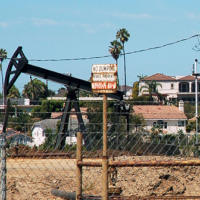SoCal Air Board Doesn’t Wait for State, Passes Own Fracking Rules Despite Defiant Industry
 Oil drilling in Los Angeles’ Baldwin Hills, where fracking has taken place (photo: Natural Resources Defense Council)
Oil drilling in Los Angeles’ Baldwin Hills, where fracking has taken place (photo: Natural Resources Defense Council)
The South Coast Air Quality Management District (AQMD) approved regulations (pdf) last week governing the controversial oil and gas extraction process of hydraulic fracturing, better known as fracking, despite foot-dragging by state regulators and over the objections of a defiant energy industry.
The new rules approved by the board require drillers to give notice when they are planning to commence fracking and let the public know what chemicals they will be pumping into the ground. The industry has fought doing either of those things and hinted they won’t abide by the ruling.
“We will turn our trade secrets over to the district if in fact there is a robust regulation that shows us those secrets will be protected,” Steven Flaherty of Halliburton told KPCC public radio. “We don’t believe this rule currently has those protections in place.”
Fracking, which is virtually unregulated in California although it has been around for decades, injects millions of gallons of pressurized water, chemicals (some toxic), sand and other substances into wells to crack open the rocks and allow easier access to oil and natural gas. Critics say it has been linked to groundwater contamination, air pollution, releases of methane gas, micro-earthquakes and sink holes.
Independent sources and the state estimate that more than 600 wells were fracked in 2011, but that’s just an estimate because drillers don’t have to disclose where they are fracking and what, precisely, they inject into the ground.
The state began working on fracking regulations last year, about the time it became apparent that the industry would make a major push to use the drilling technique to unlock vast potential shale oil resources in Central California. The federal government estimates that more than 60% of the nation’s shale oil is in the state and could produce 15.5 billion barrels of oil.
But the “discussion draft” of proposed state regulations released by the Department of Conservation’s Division of Oil, Gas, and Geothermal Resources in December enraged environmental groups by eviscerating the notification process and giving drillers the last say on withholding vital information about the chemicals being used, ostensibly because they are trade secrets.
AQMD officials said the agency would not reveal industry trade secrets or other proprietary data when it posts fracking information to its website. The new rules give energy companies an opportunity to appeal fracking posts before they go public.
There are more that 4,000 active wells at 275 facilities in Los Angeles and Orange counties, including the Inglewood Oil Field, which is surrounded by homes in the heart of L.A. County and known to be a fracking site.
–Ken Broder
To Learn More:
Southern California Air Regulators Adopt Fracking Rules (by Michael Mishak, Los Angeles Times)
AQMD Approves Rule Requiring Disclosure of Fracking Operations (by Molly Peterson, KPCC)
“Frackademia” Fueling “Frackomania” as California Counts Its Billions Early (by Ken Broder, AllGov California)
Proposed Rule: Notification and Reporting Requirements for Oil and Gas Wells and Chemical Suppliers (South Coast Air Quality Management District) (pdf)
- Top Stories
- Controversies
- Where is the Money Going?
- California and the Nation
- Appointments and Resignations
- Unusual News
- Latest News
- California Forbids U.S. Immigration Agents from Pretending to be Police
- California Lawmakers Urged to Strip “Self-Dealing” Tax Board of Its Duties
- Big Oil’s Grip on California
- Santa Cruz Police See Homeland Security Betrayal in Use of Gang Roundup as Cover for Immigration Raid
- Oil Companies Face Deadline to Stop Polluting California Groundwater





